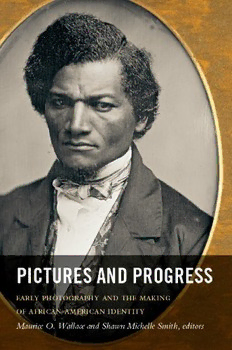
Pictures and Progress: Early Photography and the Making of African American Identity PDF
Preview Pictures and Progress: Early Photography and the Making of African American Identity
Pictures and Progress Pictures and Progress Early PhotograPhy and thE Making of african aMErican idEntity Edited by Maurice O. Wallace and Shawn Michelle Smith duke university Press durham and London 2012 © 2012 Duke University Press Chapter 5 was previously published All rights reserved as “Who’s Your Mama?: ‘White’ Printed in the United States of Mulatta Genealogies, Early America on acid- free paper ♾ Photography, and Anti-P assing Designed by Amy Ruth Buchanan Narratives of Slavery and Freedom,” Typeset in Bembo by by P. Gabrielle Foreman, American Tseng Information Systems, Inc. Literary History 14, no. 3 (2002): Library of Congress Cataloging- in- 505–39. Reprinted by permission Publication Data appear on the last of Oxford University Press. printed page of this book. Chapter 9 was previously published Frontispiece: Portrait of a woman as “‘Looking at One’s Self through with earring. Tintype, circa 1870s; the Eyes of Others’: W. E. B. Du detail. Bois’s Photographs for the 1900 Paris Exposition,” by Shawn Michelle Smith, African American Review 34, no. 4 (Winter 2000): 581–99, and reprinted in The Souls of Black Folk: One Hundred Years Later, ed. Dolan Hubbard (Columbia: University of Missouri Press, 2003), 189–217. contents acknowlEdgMEnts vii introduction Pictures and Progress Maurice O. Wallace and Shawn Michelle Smith 1 onE “A More Perfect Likeness”: Frederick Douglass and the Image of the Nation Laura Wexler 18 two “Rightly Viewed”: Theorizations of Self in Frederick Douglass’s Lectures on Pictures Ginger Hill 41 thrEE Shadow and Substance: Sojourner Truth in Black and White Augusta Rohrbach 83 Snapshot 1 Unredeemed Realities: Augustus Washington Shawn Michelle Smith 101 four Mulatta Obscura: Camera Tactics and Linda Brent Michael Chaney 109 fivE Who’s Your Mama? “White” Mulatta Genealogies, Early Photography, and Anti- Passing Narratives of Slavery and Freedom P. Gabrielle Foreman 132 six Out from Behind the Mask: Paul Laurence Dunbar, the Hampton Institute Camera Club, and Photographic Performance of Identity Ray Sapirstein 167 Snapshot 2 Reproducing Black Masculinity: Thomas Askew Shawn Michelle Smith 204 sEvEn Louis Agassiz and the American School of Ethnoeroticism: Polygenesis, Pornography, and Other “Perfidious Influences” Suzanne Schneider 211 Eight Framing the Black Soldier: Image, Uplift, and the Duplicity of Pictures Maurice O. Wallace 244 Snapshot 3 Unfixing the Frame(- up): A. P. Bedou Shawn Michelle Smith 267 ninE “Looking at One’s Self through the Eyes of Others”: W. E. B. Du Bois’s Photographs for the Paris Exposition of 1900 Shawn Michelle Smith 274 tEn Ida B. Wells and the Shadow Archive Leigh Raiford 299 Snapshot 4 The Photographer’s Touch: J. P. Ball Shawn Michelle Smith 321 ElEvEn No More Auction Block for Me! Cheryl Finley 329 BiBliograPhy 349 contriButors 369 indEx 373 acknowLedgments The completion of this volume is owed to the generosity of several people and institutions. We thank the Arts and Sciences Council Committee on Faculty Research at Duke University for its support of a two- day sympo- sium where this project had its formal genesis. Also at Duke, Karen Glynn, the visual materials archivist in the Rare Book, Manuscript, and Special Collections Library at Perkins Library, deserves special mention for her support of Pictures and Progress since the inception of this collaboration. We are indebted to Alisha Damron, Alana Damron, and Ashon Crawley for research assistance. At Duke University Press, we could not have asked for a more patient and expert partnership than the one we have with Ken Wissoker and Leigh Barnwell. There is little doubt their enthusiasm for our project improved this volume as we worked to make Pictures and Progress worthy of the care and attention Ken and Leigh gave to it. We are also grateful to Rebecca Fowler and Alex Wolfe for their help in attending to the details of the manuscript in the process of production. We want to thank as well all of the contributors to this book. Their cooperation and trust in us was a real gift in this undertaking. Pam and Joe, we reserve our most profound gratitude for you. Oxford University Press, African American Review, and the University of Missouri Press have graciously given permission to reprint two articles for this volume. introduction Pictures and Progress Maurice O. Wallace and Shawn Michelle Smith No other means of representing human likeness has been used more systematically to describe and formulate American identity than photography. Envisioning and exhibiting the American self has been a photographic venture since the inception of the medium. It is an ongoing social, cultural, and political project. —Coco Fusco, “Racial Time, Racial Marks, Racial Metaphors” Perhaps only now, at the dawn of our digital age, with our witness to the dramatic transformations wrought by this revolution still ongoing, has the comparable impact of photography’s magic on the nineteenth century begun to be fully appreciated. With the mechanical and electronic repro- duction of images in the modern mass media animating so much of our cultural lives and prepossessing so much scholarly thought, serious atten- tion cannot but return to the material beginnings of our visual dispensa- tion. Today, owing to historians, cultural critics, and theorists as vital to the study of early photographic practices as Alan Trachtenberg, Laura Wexler, Deborah Willis, Allan Sekula, and the late Susan Sontag,1 what Walter Benjamin portrayed as “the fog which obscures the beginnings of photog- raphy” seems, at last, to be dissipating.2 The signal importance of photog- raphy’s advent to modernity’s hold on history is now clearly in view. To be sure, photography was a watershed invention. So profound was the influence of photography upon antebellum and postbellum Ameri- can life and thought that, like today’s digital technology, early photog-
